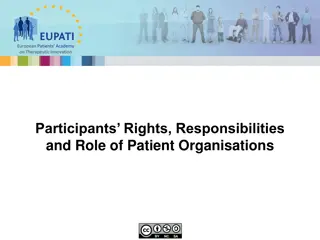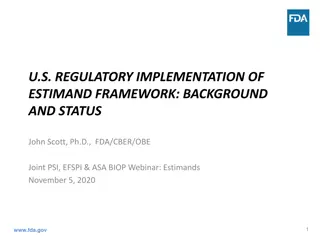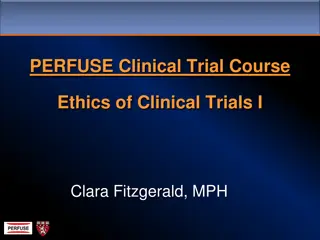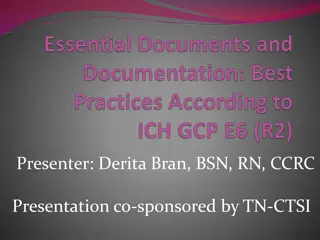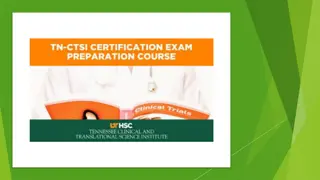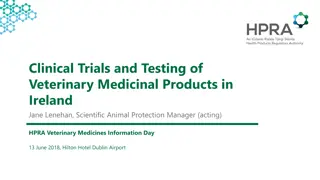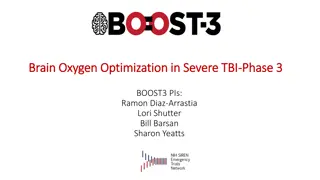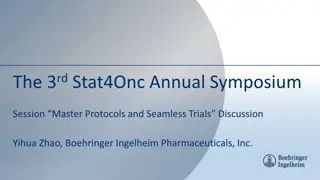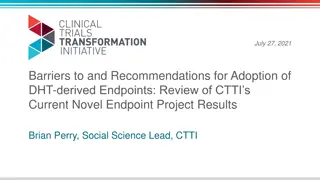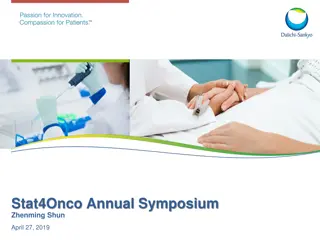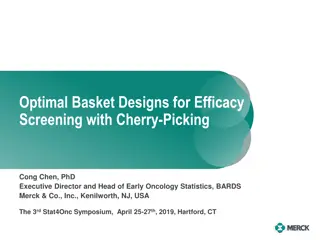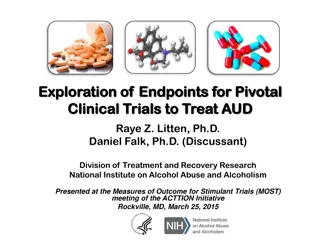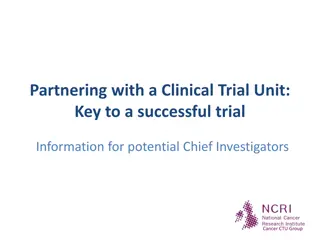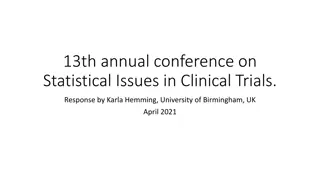Understanding Estimands in Oncology Clinical Trials
The concept of estimands in oncology clinical trials plays a crucial role in defining treatment effects and analyzing overall survival outcomes. This framework aims to enhance transparency, align trial objectives, and strengthen interdisciplinary dialogues. Introduced by the ICH E9(R1) guideline in 2019, estimands explicitly consider intercurrent events like treatment switching. By defining five key attributes, estimands help address the scientific questions of interest, especially in the context of oncology research.
Download Presentation

Please find below an Image/Link to download the presentation.
The content on the website is provided AS IS for your information and personal use only. It may not be sold, licensed, or shared on other websites without obtaining consent from the author. Download presentation by click this link. If you encounter any issues during the download, it is possible that the publisher has removed the file from their server.
E N D
Presentation Transcript
Estimands Estimands for Overall Survival in Clinical Trials for Overall Survival in Clinical Trials with Treatment Switching in Oncology with Treatment Switching in Oncology Juliane Manitz, Natalia Kan-Dobrosky, Hannes Buchner, Marie-Laure Casadebaig, Evgeny Degtyarev, Jyotirmoy Dey, Vincent Haddad, Jie Fei, Emily Martin, Mindy Mo, Kaspar Rufibach, Yue Shentu, Viktoriya Stalbovskaya, Rui Tang, Godwin Yung, Jiangxiu Zhou On behalf of the Pharmaceutical Industry Working Group on Estimands in Oncology (www.oncoestimand.org) sponsored by PSI and EFSPI and ASA scientific working group of the ASA biopharmaceutical section.
Oncology Estimands WG initiated and led by Evgeny Degtyarev (Novartis) and Kaspar Rufibach (Roche), first TC Feb 2018 EFSPI Special Interest Group (Nov 2018) and ASA Biopharm Section Scientific Working Group (Apr 2019) Large number of members from Europe and US representing 24 companies Goal: A common understanding and consistent implementation across industry in dialogue with regulators from EMA, FDA, Japan, China, Taiwan, Canada, MHRA Weblink www.oncoestimand.org.
Background ICH E9(R1) guideline introduced the estimand framework in November 2019 Aim: Increase transparency with respect to data analysis and inference Align trial objectives and statistical analyses by requiring a precise definition of the population quantity of interest Strengthen the dialogues between disciplines involved in the formulation of clinical study objectives, design, conduct, analysis and interpretation
What is an Estimand? Estimand is the target of estimation to address the scientific question of interest posed by the study objective. An estimand is described by five attributes, defining together the treatment effect of interest. This definition explicitly accounts for intercurrent events, such as switching to new anticancer therapies for the analysis of overall survival (OS), the gold standard in oncology. Def.: Intercurrent events occur after treatment initiation but before observing the study endpoint, e.g. the start of new therapy when the endpoint is overall survival Population of patients targeted Treatment condition of interest Estimand Strategies for addressing intercurrent events Variable (or endpoint) Population- level summary 4
Randomized Clinical Trial in Oncology: A Stylized Example
Treatment Switching Scenario 1: Cross-over from Control to Investigational Arm
Treatment Switching Scenario 2: From Control to Same Drug Class as of Investigational Arm
Treatment Switching Scenario 3: From Control Arm to Drug Class of Interest
A More Realistic Example: Mix of Treatment Switching Scenarios
What do we actually measure? What are the key questions? The traditional approach ignores treatment switching and rest on the following assumptions: Subsequent therapy reflect clinical practice (including investigational drug in later line) in particular decision context Patients receiving subsequent treatments (from same class as investigational drug and drug class of interest) and dose intensity as expected (as SOC) between investigational and control arm If these assumptions do not hold, we may consider to estimate the OS benefit that is attributable to the investigational drug The estimand framework provides a coherent framework to make the arising issues of treatment switching explicit and offers a systematic and transparent approach for assessment
Treatment Policy Strategy for Treatment Switching Objective:Evaluate OS benefit assuming subsequent therapies represent clinical practice Estimand: Population: Defined through appropriate I/E criteria to reflect the target patient population for approval Variable: Overall survival, defined as the time from randomization to death Treatment: Sequence of investigational drug + any subsequent therapies vs. sequence of control + any subsequent therapies (including Investigational drug) Handling of intercurrent events: Start of subsequent therapy at any time: Treatment policy Crossover to investigational drug at any time: Treatment policy Crossover to investigational drug at disease progression: Treatment policy Population-level Summary: Hazard ratio and confidence interval Estimate: Cox model and KM estimates using ITT approach
Hypothetical Strategy for Treatment Switching Objective:Evaluate OS benefit adjusted for treatment switching Estimand: Population: Defined through appropriate I/E criteria to reflect the target patient population for approval Variable: Overall survival, defined as the time from randomization to death Treatment: Investigational drug vs control (if there were no subsequent therapies) Handling of intercurrent events: Start of subsequent therapy at any time: Hypothetical Crossover to investigational drug at any time: Hypothetical Crossover to investigational drug at disease progression: Hypothetical Population-level Summary: Hazard ratio and confidence interval Estimate: Adjusted HR and CI from IPCW-weighted Cox model
Conclusions & Summary Treatment policy estimand may not be clinically relevant if subsequent therapy does not represent clinical practice The estimand framework provides a coherent framework to make the issues of treatment switching explicit and offers a systematic and transparent approach for assessment Start to think about possible treatment switching scenarios during the planning phase of a trial Choose appropriate estimand according to pre-specified scientific question of interest Treatment switching methods which can be applied if the necessary data is collected; assumptions apply Further reading: Corresponding manuscript published in Pharmaceutical Statistics (DOI: 10.1002/pst.2158)



























